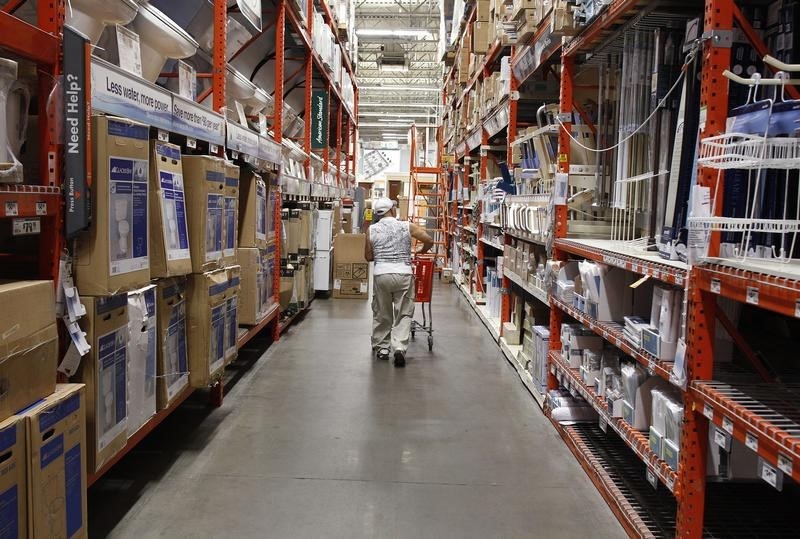By Lucia Mutikani
WASHINGTON (Reuters) - U.S. economic growth cooled in the fourth quarter as previously reported and after-tax corporate profits recorded their biggest drop since early 2011, as a strong dollar dented the earnings of multinational corporations.
Gross domestic product expanded at a 2.2 percent annual rate last quarter, the Commerce Department said on Friday in its third estimate of GDP. That was unrevised from the forecast last month.
Businesses throttled back on inventory and equipment investment, but robust consumer spending limited the slowdown in the pace of activity in the fourth quarter. The economy grew at a 5 percent rate in the third quarter.
After-tax corporate profits declined $57.1 billion, the biggest fall since the first quarter 2011, after rising $52.4 billion in the third quarter. Corporate profits from outside the United States decreased $36.1 billion after increasing $16.5 billion in the previous quarter.
Multinationals such as technology giant IBM (N:IBM), semiconductor maker Intel Corp (O:INTC), industrial conglomerate Honeywell (N:HON) and Procter & Gamble (N:PG), the world's largest household products maker, have warned that the dollar will hurt profits this year.
The dollar gained 7.8 percent against the currencies of the main U.S. trading partners between June and December.
Weak profits could undermine business spending on equipment and hiring. For all of 2014, profits fell 8.3 percent, the largest annual drop since 2008.
Economists polled by Reuters had expected fourth-quarter GDP growth would be revised up to a 2.4 percent rate.
U.S. Treasury yields fell after the data, while the U.S. dollar pared gains against the euro and hit a session low against the yen. U.S. stock index futures were trading slightly weaker.
DOLLAR HEADWINDS
Slower economic growth together with benign inflation could prompt the Federal Reserve to delay raising interest rates until later this year. The U.S. central bank has kept its short-term lending rate near zero since December 2008.
Fed officials last week lowered their individual growth estimates for this year through 2017.
The moderate pace of the U.S. economic expansion appears to have persisted through the first quarter.
The sturdy dollar, lingering weakness in Europe and Asia, harsh winter weather in the United States and a now-settled labour dispute at busy U.S. West Coast ports dampened activity in first two months of the year.
With temperatures rising, there are signs of some pick-up in activity. But the dollar will likely provide a challenge for domestic manufacturers.
First-quarter growth estimates range between a 0.9 percent and 1.4 percent rate.
Businesses accumulated $80 billion worth of inventory in the fourth quarter, less than the $88.4 billion the government had estimated last month.
As a result, inventories subtracted 0.10 percentage point from GDP growth in the fourth quarter. Restocking was previously reported to have added 0.1 percentage point to output.
The weak pace of restocking, however, removes the threat of an inventory overhang, giving businesses scope to place more orders for goods, which should help to stimulate manufacturing.
Business investment on equipment was revised to show it rising at a 0.6 percent rate instead of the previously reported 0.9 percent pace.
The slower rate of expansion in equipment spending likely reflected the strong dollar and lower crude oil prices, which caused a drop in drilling and exploration activity.
But consumer spending, which accounts for more than two-thirds of U.S. economic activity, increased at a 4.4 percent rate in the fourth quarter instead of the 4.2 percent rate reported last month. It was the fastest pace since the first quarter of 2006.
Despite the strong consumption, inflation pressures were muted. The personal consumption expenditures price index fell at an unrevised 0.4 percent rate - the weakest reading since early 2009.
Excluding food and energy, prices rose at an unrevised 1.1 percent pace, the slowest since the second quarter of 2013.
Consumer spending, however, moderated early in the first quarter as cold and snowy weather kept shoppers at home. Households also appear to have opted to save the bulk of their savings from lower gasoline prices.
Despite slower global demand, export growth was revised higher. But with consumer spending so strong, more imports than previously estimated flowed into the country, resulting in a trade deficit that weighed on GDP growth.
Trade lopped off 1.03 percentage points instead of the 1.15 points reported last month.

Residential construction spending in the fourth quarter was revised up, while government spending was a touch weaker than previously reported.